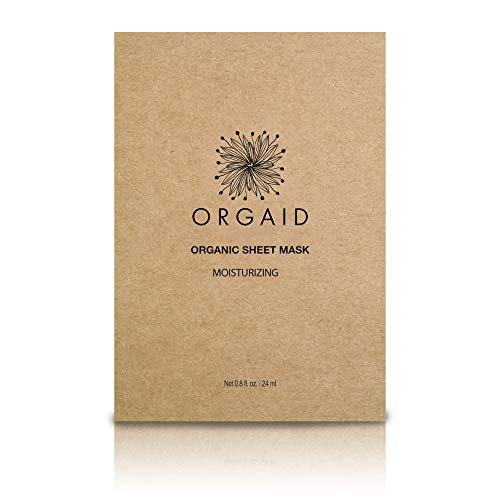
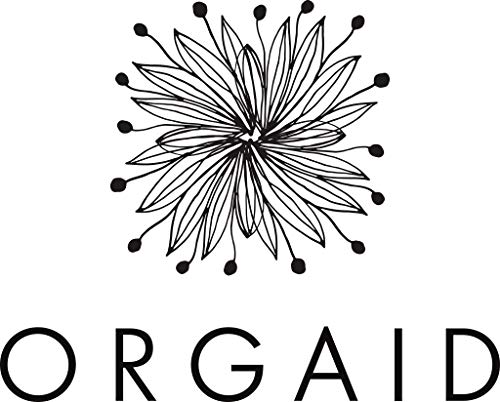
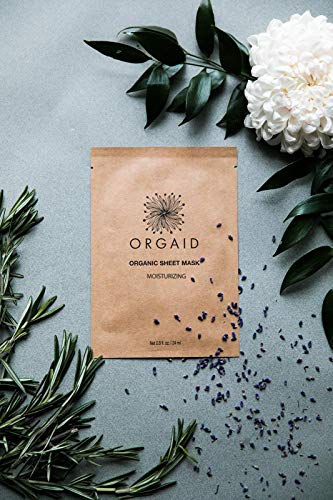
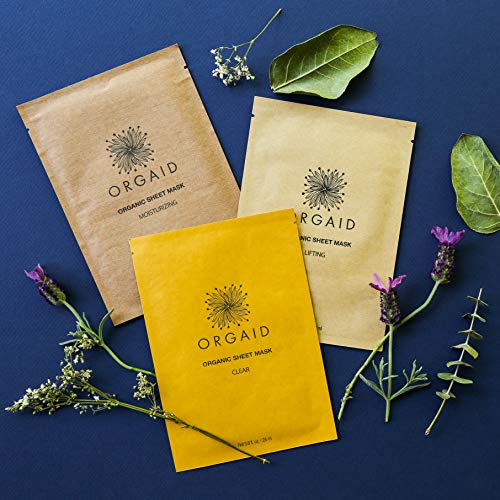
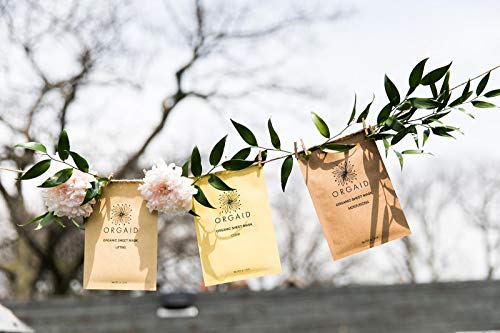
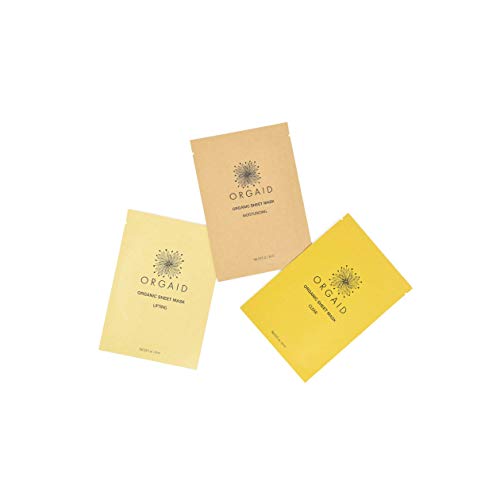


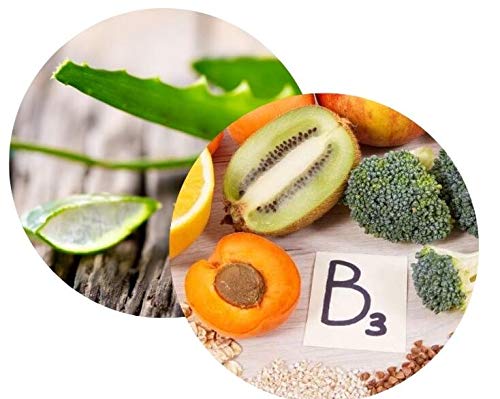
ORGAID Organic Sheet Mask - Anti-Aging & Moisturizing, Made in USA - Single Use


Rosmarinus Officinalis (Rosemary) Leaf Extract
Medium RiskRosemary leaf extract is produced from the leaves of the Rosmarinus officinalis plant. It is commonly used in cosmetic formulations for its potential antioxidant properties and fragrance. The extract may also contribute to the preservation of products due to its antimicrobial characteristics.
Sustai Insights
Rosemary leaf extract offers functional benefits such as antioxidant and antimicrobial properties, which can enhance product stability and shelf-life. It is generally considered low risk for carcinogenicity and reproductive toxicity, but it carries a moderate potential for allergic reactions. Environmentally, it poses low risk with no significant pollutant or bioaccumulation concerns. Regulatory bodies have not placed significant restrictions on its use, although some verified products cannot contain certain concentrations. Overall, the ingredient's risk level is medium, necessitating careful usage practices to mitigate allergic responses.
Camellia Sinensis (Green Tea) Leaf Extract
Medium RiskCamellia sinensis (green tea) leaf extract is derived from the leaves of the Camellia sinensis plant, primarily known for its antioxidant properties. It is commonly used in cosmetic formulations for its potential to soothe the skin and provide protective benefits against environmental stressors.
Sustai Insights
Camellia sinensis leaf extract offers functional benefits, including antioxidant properties that may protect the skin from damage and enhance product efficacy. While generally regarded as safe, it presents moderate allergenic potential and low concerns for carcinogenic or reproductive toxicity. Environmental risks are minimal; however, the sourcing practices should be evaluated for sustainability. Regulatory bodies do not impose significant restrictions, indicating a low-risk profile overall. Safe usage practices are advisable, and alternatives include other botanical extracts with similar benefits.
Glycerin
Medium RiskGlycerin (also called glycerol) is a naturally occurring compound commonly used in personal care and cosmetic products. It functions as a humectant, attracting moisture to the skin, and is also utilized as a solvent and emollient to enhance product texture and stability.
Sustai Insights
Glycerin is valued for its effective moisturizing properties and biodegradability, making it a widely accepted ingredient in formulations. It poses low health risks, including low concerns for carcinogenicity and allergies. However, moderate use restrictions exist due to regulatory guidelines. While glycerin does not significantly contribute to environmental pollution, its production process should be ethically sourced. Overall, glycerin holds a medium risk level, emphasizing the importance of safe usage practices and considering sustainable alternatives.
Hyaluronic Acid
Low RiskHyaluronic acid is a natural polysaccharide found in connective tissues, skin, and cartilage, primarily serving as a moisture-retaining agent in cosmetic products. Its primary function is to provide hydration and improve skin elasticity, making it a common ingredient in moisturizers and serums.
Sustai Insights
Hyaluronic acid offers significant functional benefits, such as effective hydration and skin plumping, while being biodegradable and generally recognized as safe by regulatory bodies. Health risks are minimal, with low concerns regarding carcinogenicity, allergies, or reproductive toxicity. Environmental risks are also low, as it is not considered a pollutant or bioaccumulative. Regulatory bodies have not issued major advisories against its use, resulting in an overall low-risk assessment. For safe usage, it is recommended to apply in appropriate concentrations. Alternatives include glycerin or aloe vera, which also provide hydration.
Salix Alba (White Willow) Bark Extract
Low RiskSalix alba (white willow) bark extract is an extract derived from the bark of the white willow tree. It is primarily known for its use in various cosmetic and personal care products, where it functions as an anti-inflammatory and soothing agent.
Sustai Insights
Salix alba bark extract offers functional benefits such as anti-inflammatory properties, which can aid in skin soothing and irritation reduction. It is generally considered low risk regarding health concerns, including carcinogenicity and allergies. Regulatory bodies, including the FDA, have not flagged it for significant health risks. Environmentally, it does not contribute substantially to pollution or bioaccumulation. Overall, this ingredient is assessed as low risk, with safe usage practices recommended. Alternatives can include other plant-based extracts with similar properties.
Niacinamide
Low RiskNiacinamide, also known as nicotinamide, is a form of vitamin B3 (niacin) that serves various functions in skincare and cosmetic products. It is often used for its potential benefits in improving skin texture, enhancing moisture retention, and supporting the skin's barrier function.
Sustai Insights
Niacinamide provides functional benefits such as enhancing skin hydration and improving the appearance of uneven skin tone. It is generally recognized as safe, with low concerns regarding carcinogenicity, allergies, or reproductive toxicity. However, enhanced skin absorption may pose risks for sensitive individuals. Regulatory bodies impose few restrictions on its use, and it is considered low risk overall. For safer alternatives, options like panthenol may be considered. Overall, niacinamide is a low-risk ingredient when used appropriately.
Lonicera Japonica (Honeysuckle) Flower Extract
Low RiskLonicera japonica (honeysuckle) flower extract is derived from the flowers of the honeysuckle plant. It is commonly used in cosmetic formulations for its potential soothing and anti-inflammatory properties. The extract may also provide some antioxidant benefits, contributing to the overall stability and performance of the product.
Sustai Insights
Honeysuckle flower extract offers functional benefits, including soothing and anti-inflammatory effects, which can enhance skin feel in formulations. It is considered low risk for health concerns, such as carcinogenicity, allergies, and reproductive toxicity, with no significant environmental hazards reported. Regulatory bodies do not impose restrictions on its use, supporting its safety profile. Safe usage practices should be followed, although alternatives such as chamomile extract may offer similar benefits with potentially different profiles. Overall, the ingredient presents a low risk assessment.
Hamamelis Virginiana (Witch Hazel) Water
Low RiskHamamelis virginiana (witch hazel) water is an aqueous extract derived from the bark and leaves of the witch hazel plant. It is commonly used in cosmetic formulations for its astringent, soothing, and anti-inflammatory properties, primarily targeting skin care applications.
Sustai Insights
Witch hazel water offers functional benefits such as skin toning and reducing irritation, making it a popular choice in cosmetic products. It is sustainably sourced and biodegradable. Health risks are minimal, with low concerns regarding carcinogenicity, allergies, or developmental toxicity. Environmental impact is generally low, with no significant pollutant or bioaccumulation concerns noted. Regulatory status is favorable, with no major advisories. Safe usage practices should be observed, especially for sensitive skin. Alternatives may include aloe vera or rose water for similar benefits. Overall, the risk associated with witch hazel water is assessed as low.
Equisetum Arvense (Horsetail) Extract
Low RiskEquisetum arvense extract is derived from the horsetail plant, known for its high silica content. It is commonly used in cosmetic formulations for its potential benefits in promoting healthy skin and hair, as well as its role as a natural preservative due to its antioxidant properties.
Sustai Insights
Equisetum arvense extract offers functional benefits including enhancing skin and hair health through its silica content and antioxidant properties. It is sustainably sourced and biodegradable. Health risks are minimal, with low concerns for carcinogenicity, allergies, and reproductive toxicity. Environmental risks are also low, with no significant pollutant or bioaccumulative effects noted. Regulatory bodies do not list this ingredient as restricted. Overall, the risk level is assessed as low, making it a safe option in cosmetic products.
Lonicera Caprifolium (Honeysuckle) Flower Extract
Low RiskLonicera caprifolium (honeysuckle) flower extract is derived from the flowers of the honeysuckle plant. It is commonly used in cosmetic formulations for its potential soothing and fragrance properties, as well as its role as a natural extract in various personal care products.
Sustai Insights
Honeysuckle flower extract offers functional benefits, including soothing properties and potential antioxidant effects. It is generally regarded as low risk for health concerns, including carcinogenicity, allergenic potential, and developmental toxicity. Environmentally, it presents low risks for pollution and bioaccumulation. Regulatory assessments do not list significant warnings or restrictions. Overall, it is considered low risk, with safe usage practices advisable, and alternatives include other natural extracts with similar properties.
Lactobacillus Ferment
Low RiskLactobacillus ferment is an extract of the probiotic bacterium Lactobacillus, commonly used in cosmetic and personal care products for its potential skin health benefits. It is known for its role in fermentation processes, contributing to the formulation's efficacy as a skin conditioning agent.
Sustai Insights
Lactobacillus ferment offers functional benefits by improving skin hydration and barrier function, and it is often derived from sustainable sources. Health risks are low, with minimal concerns regarding carcinogenicity, allergies, or reproductive toxicity. Environmentally, it poses low risks, with no significant pollutant or bioaccumulation potential. Regulatory agencies do not impose restrictions on its use. Overall, the ingredient is assessed as low risk, and safe usage practices should be followed. Alternatives such as other probiotic extracts may be considered for similar benefits.
Arginine
Low RiskArginine is a naturally occurring amino acid that plays a critical role in various biological processes, including protein synthesis and the production of nitric oxide, which is important for vasodilation. It is commonly used in dietary supplements and functional foods.
Sustai Insights
Arginine offers functional benefits such as promoting blood flow and supporting muscle metabolism. It is not associated with significant health risks, as concerns regarding carcinogenicity, allergies, and reproductive toxicity are low. Environmentally, it presents minimal risks, being biodegradable and not classified as a pollutant. Regulatory bodies have not imposed specific restrictions on arginine. Overall, the risk level is low, indicating that arginine can be safely used in products, though safe usage practices should be followed.
Lavandula Angustifolia (Lavender) Flower Extract
Low RiskLavandula angustifolia (lavender) flower extract is derived from the flowers of the lavender plant. It is commonly used in cosmetic and personal care products for its fragrance and potential calming properties. The extract may also possess mild antimicrobial properties, making it a popular ingredient in formulations.
Sustai Insights
Lavender flower extract offers functional benefits such as fragrance enhancement and potential antimicrobial effects. It is generally considered safe, with low concerns regarding carcinogenicity, allergies, and reproductive toxicity. Environmentally, it poses minimal risks and is not known to bioaccumulate. Regulatory bodies have not imposed significant restrictions on its use, indicating low overall risk. For safe use, it is recommended to avoid contact with sensitive areas. While no specific alternatives are necessary, other botanical extracts could provide similar benefits.
Maltodextrin
Low RiskMaltodextrin is a saccharide material obtained from starch through partial hydrolysis. It is commonly used as a thickener, filler, or preservative in food and cosmetic products due to its ability to enhance texture and stability.
Sustai Insights
Maltodextrin serves as an effective thickener and stabilizer in various products, and it is typically derived from renewable sources. Health risks are minimal, as it poses low concerns for carcinogenicity, allergies, and developmental toxicity. Environmental impacts are also low, with no significant pollutant or bioaccumulation potential. Regulatory bodies do not impose major restrictions on its use. Overall, maltodextrin presents a low-risk profile, making it a widely accepted ingredient in food and cosmetic formulations.
Water
Low RiskWater is a clear, colorless liquid essential for various biological processes. It serves as a solvent in formulations, facilitating the dissolution of other ingredients and enhancing product texture and application. Additionally, water plays a crucial role in hydration and is a key component in many cosmetic and personal care products.
Sustai Insights
Water is an effective solvent and hydrator, contributing to the texture and efficacy of formulations. It is biodegradable and generally regarded as safe, with low concerns regarding carcinogenicity, allergies, and reproductive toxicity. However, excessive water usage can lead to environmental concerns, particularly regarding resource depletion. Regulatory bodies do not impose restrictions on water use in cosmetics. Overall, the risks associated with water are low, making it a safe and essential ingredient.
Xanthan Gum
Low RiskXanthan gum is a polysaccharide, a sugar-based compound produced by the fermentation of glucose or sucrose. It is commonly used as a thickening agent and stabilizer in various food and cosmetic products due to its ability to improve texture and prevent ingredient separation.
Sustai Insights
Xanthan gum serves effectively as a thickener and stabilizer, enhancing product texture and consistency. It is biodegradable and typically derived from renewable sources, supporting sustainability efforts. Health risks are minimal, with low concerns regarding carcinogenicity, allergies, and reproductive toxicity. Environmental impact is similarly low, posing no significant hazards. Regulatory agencies, including the FDA, regard it as safe for use, with no significant restrictions. Overall, xanthan gum is assessed as low risk, making it a suitable ingredient in formulations.
Aloe Barbadensis (Aloe Vera) Leaf Juice
Low RiskAloe barbadensis (aloe vera) leaf juice is derived from the succulent aloe vera plant, known for its hydrating and soothing properties. It is commonly used in cosmetic formulations for its moisturizing effects and is often included in products aimed at skin care and healing.
Sustai Insights
Aloe vera leaf juice offers functional benefits as a moisturizer and skin soothing agent, while being sustainably sourced and biodegradable. Health risks are low, with minimal concerns regarding carcinogenicity, allergies, and reproductive toxicity. Environmental impact is also low, with no significant pollutants identified. Regulatory agencies impose few restrictions. Overall, the ingredient poses a low risk, making it a favorable choice in cosmetic formulations.
Hyaluronic Acid
Low RiskHyaluronic acid is a natural polysaccharide found in connective tissues, skin, and cartilage, primarily serving as a moisture-retaining agent in cosmetic products. Its primary function is to provide hydration and improve skin elasticity, making it a common ingredient in moisturizers and serums.
Sustai Insights
Hyaluronic acid offers significant functional benefits, such as effective hydration and skin plumping, while being biodegradable and generally recognized as safe by regulatory bodies. Health risks are minimal, with low concerns regarding carcinogenicity, allergies, or reproductive toxicity. Environmental risks are also low, as it is not considered a pollutant or bioaccumulative. Regulatory bodies have not issued major advisories against its use, resulting in an overall low-risk assessment. For safe usage, it is recommended to apply in appropriate concentrations. Alternatives include glycerin or aloe vera, which also provide hydration.
Salix Alba (White Willow) Bark Extract
Low RiskSalix alba (white willow) bark extract is an extract derived from the bark of the white willow tree. It is primarily known for its use in various cosmetic and personal care products, where it functions as an anti-inflammatory and soothing agent.
Sustai Insights
Salix alba bark extract offers functional benefits such as anti-inflammatory properties, which can aid in skin soothing and irritation reduction. It is generally considered low risk regarding health concerns, including carcinogenicity and allergies. Regulatory bodies, including the FDA, have not flagged it for significant health risks. Environmentally, it does not contribute substantially to pollution or bioaccumulation. Overall, this ingredient is assessed as low risk, with safe usage practices recommended. Alternatives can include other plant-based extracts with similar properties.
Niacinamide
Low RiskNiacinamide, also known as nicotinamide, is a form of vitamin B3 (niacin) that serves various functions in skincare and cosmetic products. It is often used for its potential benefits in improving skin texture, enhancing moisture retention, and supporting the skin's barrier function.
Sustai Insights
Niacinamide provides functional benefits such as enhancing skin hydration and improving the appearance of uneven skin tone. It is generally recognized as safe, with low concerns regarding carcinogenicity, allergies, or reproductive toxicity. However, enhanced skin absorption may pose risks for sensitive individuals. Regulatory bodies impose few restrictions on its use, and it is considered low risk overall. For safer alternatives, options like panthenol may be considered. Overall, niacinamide is a low-risk ingredient when used appropriately.
Lonicera Japonica (Honeysuckle) Flower Extract
Low RiskLonicera japonica (honeysuckle) flower extract is derived from the flowers of the honeysuckle plant. It is commonly used in cosmetic formulations for its potential soothing and anti-inflammatory properties. The extract may also provide some antioxidant benefits, contributing to the overall stability and performance of the product.
Sustai Insights
Honeysuckle flower extract offers functional benefits, including soothing and anti-inflammatory effects, which can enhance skin feel in formulations. It is considered low risk for health concerns, such as carcinogenicity, allergies, and reproductive toxicity, with no significant environmental hazards reported. Regulatory bodies do not impose restrictions on its use, supporting its safety profile. Safe usage practices should be followed, although alternatives such as chamomile extract may offer similar benefits with potentially different profiles. Overall, the ingredient presents a low risk assessment.
Hamamelis Virginiana (Witch Hazel) Water
Low RiskHamamelis virginiana (witch hazel) water is an aqueous extract derived from the bark and leaves of the witch hazel plant. It is commonly used in cosmetic formulations for its astringent, soothing, and anti-inflammatory properties, primarily targeting skin care applications.
Sustai Insights
Witch hazel water offers functional benefits such as skin toning and reducing irritation, making it a popular choice in cosmetic products. It is sustainably sourced and biodegradable. Health risks are minimal, with low concerns regarding carcinogenicity, allergies, or developmental toxicity. Environmental impact is generally low, with no significant pollutant or bioaccumulation concerns noted. Regulatory status is favorable, with no major advisories. Safe usage practices should be observed, especially for sensitive skin. Alternatives may include aloe vera or rose water for similar benefits. Overall, the risk associated with witch hazel water is assessed as low.
Rosmarinus Officinalis (Rosemary) Leaf Extract
Medium RiskRosemary leaf extract is produced from the leaves of the Rosmarinus officinalis plant. It is commonly used in cosmetic formulations for its potential antioxidant properties and fragrance. The extract may also contribute to the preservation of products due to its antimicrobial characteristics.
Sustai Insights
Rosemary leaf extract offers functional benefits such as antioxidant and antimicrobial properties, which can enhance product stability and shelf-life. It is generally considered low risk for carcinogenicity and reproductive toxicity, but it carries a moderate potential for allergic reactions. Environmentally, it poses low risk with no significant pollutant or bioaccumulation concerns. Regulatory bodies have not placed significant restrictions on its use, although some verified products cannot contain certain concentrations. Overall, the ingredient's risk level is medium, necessitating careful usage practices to mitigate allergic responses.
Equisetum Arvense (Horsetail) Extract
Low RiskEquisetum arvense extract is derived from the horsetail plant, known for its high silica content. It is commonly used in cosmetic formulations for its potential benefits in promoting healthy skin and hair, as well as its role as a natural preservative due to its antioxidant properties.
Sustai Insights
Equisetum arvense extract offers functional benefits including enhancing skin and hair health through its silica content and antioxidant properties. It is sustainably sourced and biodegradable. Health risks are minimal, with low concerns for carcinogenicity, allergies, and reproductive toxicity. Environmental risks are also low, with no significant pollutant or bioaccumulative effects noted. Regulatory bodies do not list this ingredient as restricted. Overall, the risk level is assessed as low, making it a safe option in cosmetic products.
Lonicera Caprifolium (Honeysuckle) Flower Extract
Low RiskLonicera caprifolium (honeysuckle) flower extract is derived from the flowers of the honeysuckle plant. It is commonly used in cosmetic formulations for its potential soothing and fragrance properties, as well as its role as a natural extract in various personal care products.
Sustai Insights
Honeysuckle flower extract offers functional benefits, including soothing properties and potential antioxidant effects. It is generally regarded as low risk for health concerns, including carcinogenicity, allergenic potential, and developmental toxicity. Environmentally, it presents low risks for pollution and bioaccumulation. Regulatory assessments do not list significant warnings or restrictions. Overall, it is considered low risk, with safe usage practices advisable, and alternatives include other natural extracts with similar properties.
Lactobacillus Ferment
Low RiskLactobacillus ferment is an extract of the probiotic bacterium Lactobacillus, commonly used in cosmetic and personal care products for its potential skin health benefits. It is known for its role in fermentation processes, contributing to the formulation's efficacy as a skin conditioning agent.
Sustai Insights
Lactobacillus ferment offers functional benefits by improving skin hydration and barrier function, and it is often derived from sustainable sources. Health risks are low, with minimal concerns regarding carcinogenicity, allergies, or reproductive toxicity. Environmentally, it poses low risks, with no significant pollutant or bioaccumulation potential. Regulatory agencies do not impose restrictions on its use. Overall, the ingredient is assessed as low risk, and safe usage practices should be followed. Alternatives such as other probiotic extracts may be considered for similar benefits.
Arginine
Low RiskArginine is a naturally occurring amino acid that plays a critical role in various biological processes, including protein synthesis and the production of nitric oxide, which is important for vasodilation. It is commonly used in dietary supplements and functional foods.
Sustai Insights
Arginine offers functional benefits such as promoting blood flow and supporting muscle metabolism. It is not associated with significant health risks, as concerns regarding carcinogenicity, allergies, and reproductive toxicity are low. Environmentally, it presents minimal risks, being biodegradable and not classified as a pollutant. Regulatory bodies have not imposed specific restrictions on arginine. Overall, the risk level is low, indicating that arginine can be safely used in products, though safe usage practices should be followed.
Lavandula Angustifolia (Lavender) Flower Extract
Low RiskLavandula angustifolia (lavender) flower extract is derived from the flowers of the lavender plant. It is commonly used in cosmetic and personal care products for its fragrance and potential calming properties. The extract may also possess mild antimicrobial properties, making it a popular ingredient in formulations.
Sustai Insights
Lavender flower extract offers functional benefits such as fragrance enhancement and potential antimicrobial effects. It is generally considered safe, with low concerns regarding carcinogenicity, allergies, and reproductive toxicity. Environmentally, it poses minimal risks and is not known to bioaccumulate. Regulatory bodies have not imposed significant restrictions on its use, indicating low overall risk. For safe use, it is recommended to avoid contact with sensitive areas. While no specific alternatives are necessary, other botanical extracts could provide similar benefits.
Maltodextrin
Low RiskMaltodextrin is a saccharide material obtained from starch through partial hydrolysis. It is commonly used as a thickener, filler, or preservative in food and cosmetic products due to its ability to enhance texture and stability.
Sustai Insights
Maltodextrin serves as an effective thickener and stabilizer in various products, and it is typically derived from renewable sources. Health risks are minimal, as it poses low concerns for carcinogenicity, allergies, and developmental toxicity. Environmental impacts are also low, with no significant pollutant or bioaccumulation potential. Regulatory bodies do not impose major restrictions on its use. Overall, maltodextrin presents a low-risk profile, making it a widely accepted ingredient in food and cosmetic formulations.
Camellia Sinensis (Green Tea) Leaf Extract
Medium RiskCamellia sinensis (green tea) leaf extract is derived from the leaves of the Camellia sinensis plant, primarily known for its antioxidant properties. It is commonly used in cosmetic formulations for its potential to soothe the skin and provide protective benefits against environmental stressors.
Sustai Insights
Camellia sinensis leaf extract offers functional benefits, including antioxidant properties that may protect the skin from damage and enhance product efficacy. While generally regarded as safe, it presents moderate allergenic potential and low concerns for carcinogenic or reproductive toxicity. Environmental risks are minimal; however, the sourcing practices should be evaluated for sustainability. Regulatory bodies do not impose significant restrictions, indicating a low-risk profile overall. Safe usage practices are advisable, and alternatives include other botanical extracts with similar benefits.
Water
Low RiskWater is a clear, colorless liquid essential for various biological processes. It serves as a solvent in formulations, facilitating the dissolution of other ingredients and enhancing product texture and application. Additionally, water plays a crucial role in hydration and is a key component in many cosmetic and personal care products.
Sustai Insights
Water is an effective solvent and hydrator, contributing to the texture and efficacy of formulations. It is biodegradable and generally regarded as safe, with low concerns regarding carcinogenicity, allergies, and reproductive toxicity. However, excessive water usage can lead to environmental concerns, particularly regarding resource depletion. Regulatory bodies do not impose restrictions on water use in cosmetics. Overall, the risks associated with water are low, making it a safe and essential ingredient.
Glycerin
Medium RiskGlycerin (also called glycerol) is a naturally occurring compound commonly used in personal care and cosmetic products. It functions as a humectant, attracting moisture to the skin, and is also utilized as a solvent and emollient to enhance product texture and stability.
Sustai Insights
Glycerin is valued for its effective moisturizing properties and biodegradability, making it a widely accepted ingredient in formulations. It poses low health risks, including low concerns for carcinogenicity and allergies. However, moderate use restrictions exist due to regulatory guidelines. While glycerin does not significantly contribute to environmental pollution, its production process should be ethically sourced. Overall, glycerin holds a medium risk level, emphasizing the importance of safe usage practices and considering sustainable alternatives.
Xanthan Gum
Low RiskXanthan gum is a polysaccharide, a sugar-based compound produced by the fermentation of glucose or sucrose. It is commonly used as a thickening agent and stabilizer in various food and cosmetic products due to its ability to improve texture and prevent ingredient separation.
Sustai Insights
Xanthan gum serves effectively as a thickener and stabilizer, enhancing product texture and consistency. It is biodegradable and typically derived from renewable sources, supporting sustainability efforts. Health risks are minimal, with low concerns regarding carcinogenicity, allergies, and reproductive toxicity. Environmental impact is similarly low, posing no significant hazards. Regulatory agencies, including the FDA, regard it as safe for use, with no significant restrictions. Overall, xanthan gum is assessed as low risk, making it a suitable ingredient in formulations.
Aloe Barbadensis (Aloe Vera) Leaf Juice
Low RiskAloe barbadensis (aloe vera) leaf juice is derived from the succulent aloe vera plant, known for its hydrating and soothing properties. It is commonly used in cosmetic formulations for its moisturizing effects and is often included in products aimed at skin care and healing.
Sustai Insights
Aloe vera leaf juice offers functional benefits as a moisturizer and skin soothing agent, while being sustainably sourced and biodegradable. Health risks are low, with minimal concerns regarding carcinogenicity, allergies, and reproductive toxicity. Environmental impact is also low, with no significant pollutants identified. Regulatory agencies impose few restrictions. Overall, the ingredient poses a low risk, making it a favorable choice in cosmetic formulations.
Experience the transformative power of ORGAID Anti-aging & Moisturizing Organic Sheet Mask. Crafted in the USA, this single-use mask is designed for those who value effective skincare rooted in sustainability. Ideal for revitalizing tired skin, it combines hydrating organic ingredients to deliver a youthful glow while being gentle on the environment.
- Hydration Boost: Infused with organic ingredients, the mask deeply hydrates the skin, enhancing moisture levels for a plump and radiant appearance.
- Anti-aging Benefits: Target signs of aging with this mask that helps reduce the appearance of fine lines, leaving skin looking youthful and refreshed.
- Convenient Use: Simply cleanse your face, apply the mask, and relax for 15-20 minutes – perfect for a quick self-care ritual at home or on-the-go.
- Eco-conscious Choice: Made with sustainable practices, this mask is not only good for your skin but also for the planet, appealing to environmentally conscious consumers.
- Trusted Quality: Manufactured in the USA, ORGAID prioritizes safety and quality, ensuring that every mask is free from harmful chemicals, allowing you to feel confident in your skincare routine.
Subscribe & Save with Sustai
- Best Price Guarantee: Always enjoy the lowest prices on sustainable home essentials.
- No Surprises: We’ll notify you before shipping. No hidden fees, ever.
- You’re in Charge: Change, pause, or cancel your subscription anytime with ease.
- Eco-Friendly Deliveries: Our grouped shipments mean less packaging and lower emissions.
Join us on a sustainable journey. Special offers for a limited time! Prices and promotions may change.
Recommended Products
Experience the transformative power of ORGAID Anti-aging & Moisturizing Organic Sheet Mask. Crafted in the USA, this single-use mask is designed for those who value effective skincare rooted in sustainability. Ideal for revitalizing tired skin, it combines hydrating organic ingredients to deliver a youthful glow while being gentle on the environment.
- Hydration Boost: Infused with organic ingredients, the mask deeply hydrates the skin, enhancing moisture levels for a plump and radiant appearance.
- Anti-aging Benefits: Target signs of aging with this mask that helps reduce the appearance of fine lines, leaving skin looking youthful and refreshed.
- Convenient Use: Simply cleanse your face, apply the mask, and relax for 15-20 minutes – perfect for a quick self-care ritual at home or on-the-go.
- Eco-conscious Choice: Made with sustainable practices, this mask is not only good for your skin but also for the planet, appealing to environmentally conscious consumers.
- Trusted Quality: Manufactured in the USA, ORGAID prioritizes safety and quality, ensuring that every mask is free from harmful chemicals, allowing you to feel confident in your skincare routine.

You can have at most 2 Sustainable Steals products in your cart
Customer Reviews
Customers’ View
Customers appreciate the hydration and nourishing qualities of the ORGAID Organic Sheet Mask, often noting its ability to leave skin feeling intensely moisturized and rejuvenated. Many users highlight the soothing experience, with comments such as, 'After using this mask, my skin felt fabulous!' This product is also recognized for its value, with customers stating it's worth the investment despite being a bit pricier than other options. Environmentally conscious consumers find comfort in the biodegradable materials used in the mask, aligning with their values. Overall, customer feedback consistently reflects satisfaction with the product's effectiveness in enhancing skin appearance and promoting a healthy glow.
AI-generated from the text of customer reviewsThis product has no reviews yet.




